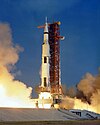Saturn A-2
 | |
| Function | Uncrewed launch vehicle |
|---|---|
| Manufacturer | Von Braun |
| Country of origin | United States |
| Size | |
| Height | 62 m (203.00 ft) |
| Diameter | 6.52 m (21.39 ft) |
| Mass | 524,484 kg |
| Stages | 3 (all used on various vehicles, now retired) |
| Launch history | |
| Status | Never flown |
| Launch sites | N/A |
| First stage - S-IB | |
| Engines | 8 × Rocketdyne H-1 |
| Thrust | 1,600,000 lbf (7,100 kN) |
| Burn time | 150 seconds |
| Propellant | RP-1/LOX |
| Second stage Jupiter Cluster | |
| Engines | 4 x Rocketdyne LR79 |
| Thrust | 3,034.285 kN |
| Burn time | 172 seconds |
| Propellant | RP-1/LOX |
| Third stage - Centaur C | |
| Engines | 2 RL-10A-1 |
| Thrust | 133 kN |
| Burn time | 430 seconds |
| Propellant | LH2 |
Studied with the Saturn A-1 in 1959, the Saturn A-2 was deemed more powerful than the Saturn I rocket, consisting of a S-IB first stage, which actually flew on the Saturn IB, a second stage which contains four S-3 engines that flew on the Jupiter IRBM and a Centaur high-energy liquid-fueled third stage.[1]
References
- ^ "Saturn A-2". www.astronautix.com. Archived from the original on December 28, 2016.
- Koelle, Heinz Hermann, Handbook of Astronautical Engineering, McGraw-Hill, New York, 1961.
- Bilstein, Roger E, Stages to Saturn, US Government Printing Office, 1980. ISBN 0-16-048909-1.

